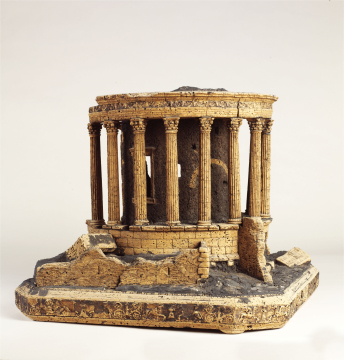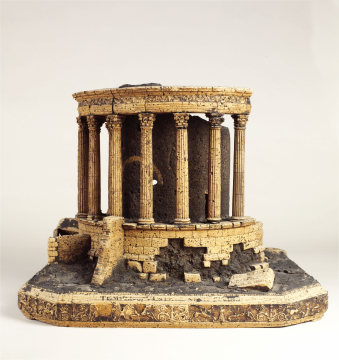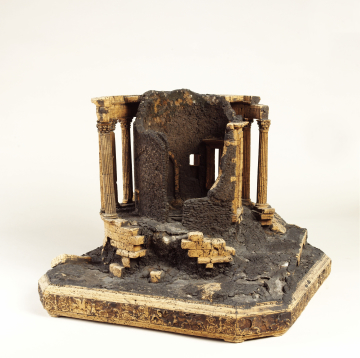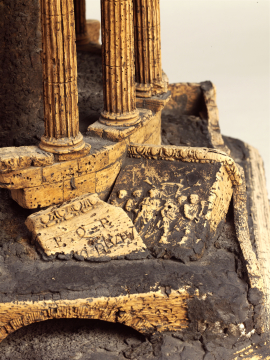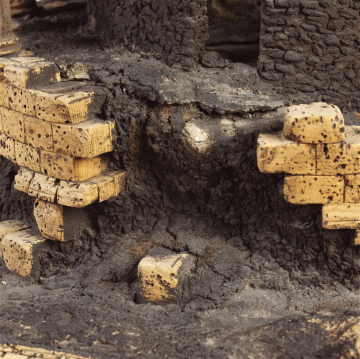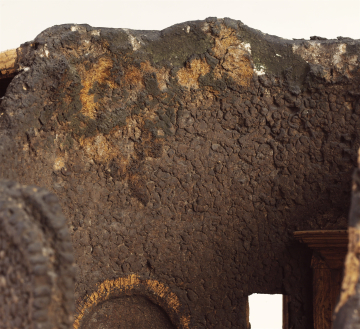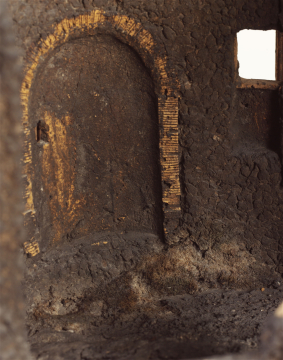Explore Collections


You are here:
CollectionsOnline
/
Model of the Roman circular Temple of Vesta at Tivoli, near Rome, by Giovanni Altieri (signed and dated 177?)
Browse
Model SM MR2. ©Sir John Soane's Museum. Photo: Hugh Kelly.
Model of the Roman circular Temple of Vesta at Tivoli, near Rome, by Giovanni Altieri (signed and dated 177?)
Cork
Height: 39.5cm
Width: 52.3cm
Depth: 51.3cm
Width: 52.3cm
Depth: 51.3cm
Museum number: MR2
On display: Model Room (pre-booked tours only)
All spaces are in No. 13 Lincoln's Inn Fields unless identified as in No. 12, Soane's first house.
For tours https://www.soane.org/your-visit
Curatorial note
This model represents Sir John Soane’s favourite classical building. He sketched the Temple, dramatically located on a cliff by a waterfall, when he was in Italy. The circular Temple was thought to have been dedicated either to the Goddess Vesta or to Hercules (circular temples dedicated to these two exist in Rome) and was founded during the Republican era in the 1st century BC. Soane used the distinctive form of the Corinthian Order of the Temple in his own architecture, most notably on the Tivoli Corner of the Bank of England. His first pupil, John Sanders, writing to him from his own Grand Tour long after he had left the office referred to the temple as 'your darling Tivoli'.
The drawings used to illustrate Soane's discussion of this temple in his Royal Academy lectures were illustrated by drawings prepared in his office which may have been based not only on measured drawings and other records but on examination of this model. Two, 19/7/3 and 19/7/4, in particular seem to reflect something of the colour and texture of cork.
This model was first displayed in the Dome area, on top of a teetering pile of fragments projecting over the void on the east side. However, when he acquired a large number of cork models in 1826 and commissioned the Pompeii model stand, he placed it directly onto the cork model of Pompeii, along with other models of buildings elsewhere, transforming it into a kind of three-dimensional capriccio, an imaginary antique landscape littered with ruins.
The drawings used to illustrate Soane's discussion of this temple in his Royal Academy lectures were illustrated by drawings prepared in his office which may have been based not only on measured drawings and other records but on examination of this model. Two, 19/7/3 and 19/7/4, in particular seem to reflect something of the colour and texture of cork.
This model was first displayed in the Dome area, on top of a teetering pile of fragments projecting over the void on the east side. However, when he acquired a large number of cork models in 1826 and commissioned the Pompeii model stand, he placed it directly onto the cork model of Pompeii, along with other models of buildings elsewhere, transforming it into a kind of three-dimensional capriccio, an imaginary antique landscape littered with ruins.
The provenance of two of Soane's cork models, MR2 (Tivoli) and MR29 (Arch of Constaintine) was thought to be, as recorded in Soane Museum records, the 'Gowan' sale held by 'Phillips', 1804, but recent research by Dr Richard Gillespie revealed in 2017 that the names were incorrectly recorded and should be McGowan (or McGouan) with the sale not by Phillips but Philipe.The sale catalogue is: Philipe, T. 1804. Catalogue of the Extensive Cabinet of Medals, Coins, Gems, Antiquities, and Books on the Fine Arts. Collected at a Liberal Expence, by John McGouan, Esq. F.R.S. Edin. Deceased. T. Philipe, Warwick Street, Golden Square, London, 8-15 February 1804 [Cadbury Research Library, University of Birmingham]
The seventh day of the sale includes: Lot 245. A cork model of the Sybil’s Temple at Tivoli /
Lot 246. A ditto of the Arch of Constantine, an elegant and elaborate performance, with all the basso relieves, inside and out, in Number 24, heighth about 7 inches, width about 89, and depth 4. It is contained in a mahogany case, glazed on both sides. The price of £16 for the two models is recorded at the Soane.
John McGouan (or McGowan) (d.1803) was an Edinburgh lawyer and antiquary; he was a fellow of the Society of Antiquaries of Scotland, as well as a foundation member of the Royal Society of Edinburgh. It is not certain whether or not he travelled to Italy, but he did acquire Italian and Asian artefacts (see Beatrice Tessier, ‘Asia in 18th-Century Edinburgh Institutions: Seen or Unseen?’, Proceedings of the Society of Antiquaries of Scotland, 134, 2004, pp.499-556).One possibility is that McGouan acquired the models from his friend Andrew Lumisden, the Jacobite politician and antiquary, who had lived in Rome from 1751-69, working as assistant secretary to the Old Pretender, then subsequently in Paris. By 1773 he had sufficiently distanced himself from the Jacobite cause to be permitted to return to Edinburgh, where he would write Remarks on the Antiquities of Rome and its Environs (1797), a successful account of the classical remains in Rome accompanied by engravings. In his later years he would share apartments with John McGouan in Princes Street, and he died there in 1801; McGouan died two years later at Princes Street. It is possible that the two models were originally acquired by Lumisden in Rome (although the Tivoli model was made in the 1770s, which appears to be after he left Rome) and either given by him during his life or subsequently bequeathed to McGouan (see James Dennistoun, Memoirs of Sir Robert Strange and ... Andrew Lumisden. 2 vols, London, 1855, Vol. 2, pp.151-163 and 273-275.
We are grateful to Dr Richard Gillespie of the University of Melbourne, for sharing his discovery of this provenance and research into John McGouan with us.
Literature
Soane, Description (1830), p. 25 pl. 10, 16
Soane, Description,1835), pp. 87.93, pl. 38
P. de la Ruffinière du Prey, John Soane,1982, p. 359 note 9
V. Kockel, Tempel i Kork, Stockholm 1992, pp. 23-26 fig. 5
Kockel in Expo. München,1993, p.13 fig. 3; p. 16 figs. 5-6
Kockel, Phelloplastica (1998), pp. 31-34 figs. 15-6, 19
John Soane Architect: Master of Space and Light, Royal Academy exhbition catalogue (1999), pp. 102-103, cat 19 (model) and cat. 20 (lecture illustration); also pp. 160-162 cats 68-69 for its display in the Dome in 1811
M. Richardson, ‘John Soane and the Temple of Vesta in Tivoli’ in Journal of the Society of Architectural Historians of Great Britain 46, 2003, pp. 127-146 in particular p.140
Complete Description, Sir John Soane's Museum, 2018
For other cork models of the same temple see Rom über die Alpen tragen p. 3303-309 and Kockel, Phelloplastica p. 57-68.
Soane, Description,1835), pp. 87.93, pl. 38
P. de la Ruffinière du Prey, John Soane,1982, p. 359 note 9
V. Kockel, Tempel i Kork, Stockholm 1992, pp. 23-26 fig. 5
Kockel in Expo. München,1993, p.13 fig. 3; p. 16 figs. 5-6
Kockel, Phelloplastica (1998), pp. 31-34 figs. 15-6, 19
John Soane Architect: Master of Space and Light, Royal Academy exhbition catalogue (1999), pp. 102-103, cat 19 (model) and cat. 20 (lecture illustration); also pp. 160-162 cats 68-69 for its display in the Dome in 1811
M. Richardson, ‘John Soane and the Temple of Vesta in Tivoli’ in Journal of the Society of Architectural Historians of Great Britain 46, 2003, pp. 127-146 in particular p.140
Complete Description, Sir John Soane's Museum, 2018
For other cork models of the same temple see Rom über die Alpen tragen p. 3303-309 and Kockel, Phelloplastica p. 57-68.
Exhibition history
John Soane Architect: Master of Space and Light, Royal Academy of Arts, London, 11 September - 3 December 1999; Centro Palladio, Vicenza, April - August 2000; Hôtel de Rohan, Paris, January - April 2001; Canadian Centre for Architecture, Montreal, 16 May - 3 September 2001; Real Academia des Bellas Artes, Madrid, October - December 2001
Thomas Girtin: The Art of Watercolour, Tate Britain, London, 4 July - 29 September 2002
In Pursuit of Antiquity: Drawings by the Giants of British Neo-Classicism, Sir John Soane's Museum, 1 February - 1 June 2008; Tchoban Foundation Museum für Architekturzeichnung, Berlin, 3 October 2015 - 14 February 2016
Thomas Girtin: The Art of Watercolour, Tate Britain, London, 4 July - 29 September 2002
In Pursuit of Antiquity: Drawings by the Giants of British Neo-Classicism, Sir John Soane's Museum, 1 February - 1 June 2008; Tchoban Foundation Museum für Architekturzeichnung, Berlin, 3 October 2015 - 14 February 2016
Associated items
Soane collections online is being continually updated. If you wish to find out more or if you have any further information about this object please contact us: worksofart@soane.org.uk
